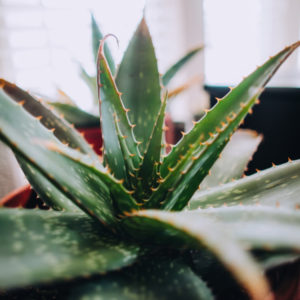Did you know that air pollution can be up to 100 times higher indoors compared to outdoors?
Yes, shockingly, according to the Environmental Protection Agency (EPA), it’s true. In fact, “More people die each year from indoor air pollution than Malaria, AIDS, and Tuberculosis combined.” (Politicfact May 2017) That’s a stunning statistic, especially considering that most people spend up to 90% of their lives indoors. The EPA has named indoor air pollution as one of the top five environmental risks to public health.
.jpg) Why is it such a problem?
Why is it such a problem?
Air is the fuel for all the cellular functions in our bodies. We need it to survive and it affects all of our body systems. When we breathe polluted air, we’re introducing toxins into every cell in our body. These toxins are simply not meant to be in our bodies and negatively impact all of our body functions.
In addition to possibly causing allergic reactions like sneezing, wheezing, itchy throat and skin, hives, watery eyes, nasal congestion, coughing, stomach aches, fatigue, and irritability, some of the air pollutants are known carcinogens, neurotoxins, immunotoxins, and hormone disrupters. One study done at the Fudan University in Shanghai, China, suggested that breathing in dirty air creates spikes in stress hormones, contributes to heart disease, stroke, type II diabetes, and shortened life spans. Doctors at a cancer center in London warned that dirty air also contributes to increases in lung cancer. Toxic air can also impact our brains with an increased risk of Alzheimer’s in children! (Queen Mary University in London) How scary!
.jpg) How does our indoor air become so filthy?
How does our indoor air become so filthy?
Many common items in our homes produce off-gasses that are constantly circulating through the air we breathe. Fumes off-gassed by building materials (often containing the embalming fluid, formaldehyde), flooring, mattresses, furniture, upholstery, indoor smoke (like fireplaces), dust, bacteria, viruses, and mold are all common indoor air pollutants. PVC chemicals from plastics, perchloroethylene (PCE) gasses from dry cleaning, VOC chemicals from paints, carpets, and even gas stoves, dryers, and water heaters, radon gas, flame retardants (PPDE), and PFC chemicals from nonstick cookware are commonly found in homes. All of these have many potential negative effects. I actually know a person who inadvertently killed several pet birds because of using nonstick cookware!
.jpg) Additionally, artificially scented candles and air fresheners utilize many chemical constituents, usually including an ingredient called fragrance. Fragrance is a blanket term for over 3500 ingredients (not just one simple ingredient) that are NOT regulated by the FDA. Companies aren’t required to disclose these chemical ingredients because they’re considered a proprietary “trade secret.” If companies did disclose what the fragrances consisted of, the ingredient list would likely be a mile long. Fragrance can include a super load of extremely toxic chemicals that should be avoided whenever possible.
Additionally, artificially scented candles and air fresheners utilize many chemical constituents, usually including an ingredient called fragrance. Fragrance is a blanket term for over 3500 ingredients (not just one simple ingredient) that are NOT regulated by the FDA. Companies aren’t required to disclose these chemical ingredients because they’re considered a proprietary “trade secret.” If companies did disclose what the fragrances consisted of, the ingredient list would likely be a mile long. Fragrance can include a super load of extremely toxic chemicals that should be avoided whenever possible.
One of the main fragrance ingredients in scented candles and air fresheners is called pthalates, plasticizers that are meant to make the scent last longer, in addition to many other uses. Not only are they found in fragrance, they’re also used in cosmetics, pesticides, plastics, cleaning supplies, and clothing. They are petroleum derivatives that are Endocrine Disrupting Chemicals (EDCs) – hazardous chemicals that are known to cause a host of problems, including cancer and learning disabilities. Because our Endocrine System is responsible for our mood, growth, metabolism, sexual development, and reproduction, phthalates are especially concerning. They mimic the hormones in our body, which then interfere with our natural hormones. By tricking our Endocrine System into mistaking EDCs for our real hormones, they disrupt normal functions and can produce many potential side effects, including obesity, diabetes, infertility, and birth defects. What’s even scarier is that EDCs are mutagens, meaning they can actually change our DNA. Talk about being genetically modified!
And if pthalates weren’t alarming enough, scented candle fragrance can also produce alkanes and alkenes, two additional known carcinogens that are found in car exhaust fumes.
Not only that, common household cleaners and products can create concentrated chemical fumes in our air. Dryer sheets are a major indoor air pollutant. Off-gassing from bug spray is another culprit – if it can kill bugs, it can likely hurt humans too. Another huge potential contributor to indoor air pollution is personal care products. Perfumes, hair sprays, nail polishes, and spray deodorants all contain synthetic chemical fragrances with pthalates.
Do some research and find out for yourself. Don’t simply take my word for it! Indoor air pollution can be a serious concern, and so many of our everyday products are contributing factors.
 How can we improve our indoor air quality?
How can we improve our indoor air quality?
This information can feel completely overwhelming, I know. We obviously aren’t going to run out and buy new “green” furniture, mattresses, paints, appliances, etc. to replace everything. Nor can we put ourselves in a bubble to quell our contact with these toxic chemicals. They’re a part of our lives, for better or worse. But being armed with this information is key because we can do our best to create a cleaner environment at home. Less exposure to these pollutants is always better.
Ventilation is key, but now that the winter months are upon us, we can’t always open windows to air out our homes. On those unusually warmer days though, throwing up the windows and opening the doors, even for just a few minutes, can be helpful. Turn on fans to help circulate the fresh air. There are some other ways we can clean up our air at home, too. Here are seven ideas:
- Take off shoes and boots before coming inside. Keep the floors cleaned and vacuumed to cut down on dust.
- Switch to non-toxic and fragrance-free alternatives for cleaners, soaps, and personal care products. Support companies you can trust. Don’t go out and replace everything all at once. Be cost effective by ditching and switching when you use up products you already own. An app like Think Dirty is a fantastic tool to learn about which products are safe – I personally try to stick with a rating of 4 or less. Also, try ditching the dryer sheets and switch to wool dryer balls (secure a safety pin to the wool balls to bring down the amount of static electricity).

- Clean and switch out air filters for your air conditioner and furnace regularly.
- Add healthy household plants to the rooms where you spend the most time. I particularly love aloe and spider plants because they’re pretty difficult to kill. They also sprout babies (when they’re well cared for) so even more plants can be added to other rooms with minimal investment. Additionally, there are plenty of natural uses for an aloe plant! A quick google search will give you some more options of plants that are especially helpful for purifying the air.
- Ditch the candles and diffuse essential oils instead. This has been a game changer for our family. Not only do pure essential oils not contain harmful synthetic chemicals that create allergic reactions, some even have properties that can help to purify the air. Quality matters though – make sure you’re buying oils from a company you can trust.
- If you have the budget, purchase a high-quality air purifier for the rooms where you spend the most time. Do your research to find a product that works best for your needs, and remember that not all air purifiers are created equal.
- Ask Santa for new cookware that doesn’t off-gas nonstick fumes. There are lots of reviews for “green” cookware that will give you an idea of which brands are safer to use.
The idea isn’t to eliminate every chemical we come in contact with. That’s incredibly unreasonable and simply impossible. But by being mindful, we can decrease our contact at home to give our bodies a break from pollutants everywhere else. As I always suggest, start small. Make one small change at a time and add something new when you’re ready.







